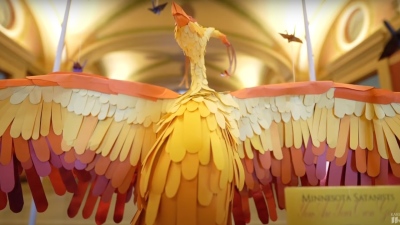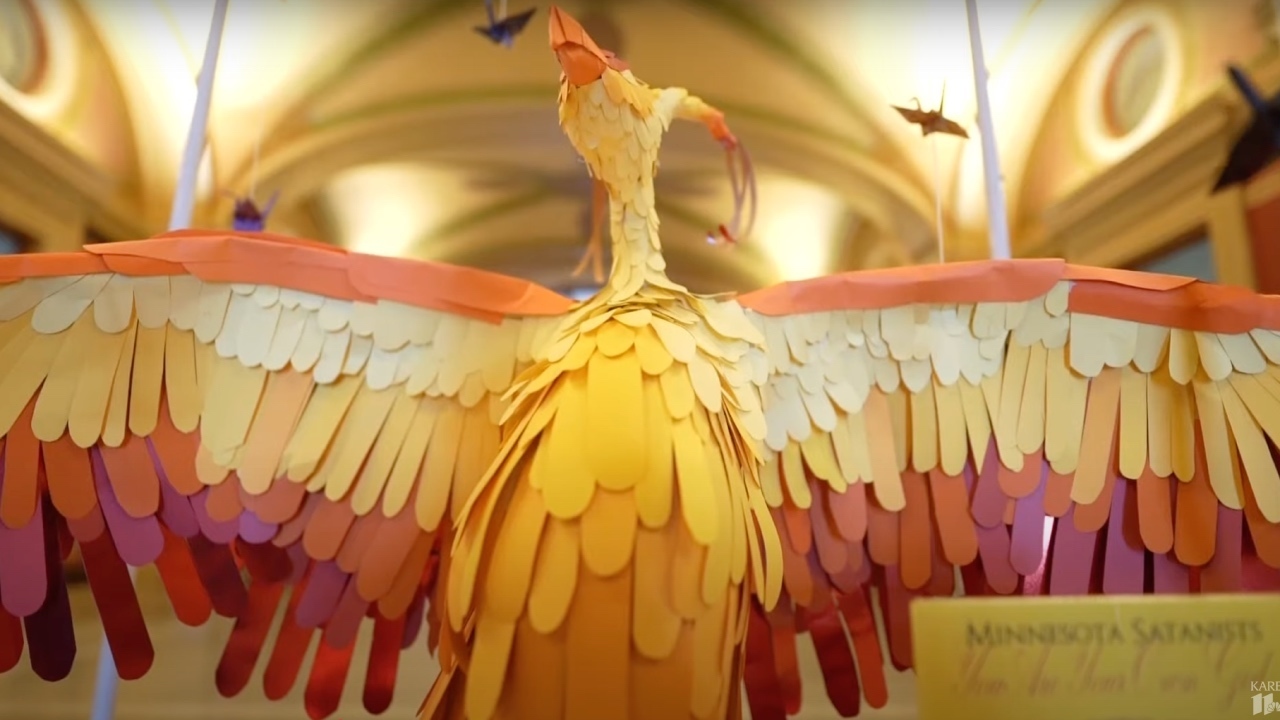
Over the past several years, a growing trend has emerged of self-professed Satanists erecting demonic shrines, idols, and statues in public places around Christmastime. During last year’s holidays, U.S. Navy veteran Michael Cassidy toppled and beheaded a Baphomet statue erected in Iowa’s state capitol building, while state Democrats in Michigan posed with a demonic idol on the state capitol building’s front lawn. This year seems to be no different, with Satanist shrines popping up across the country and American Christians pushing back against the encroachment of the demonic.
In Minnesota, an offshoot of the Satanic Temple (TST) succeeded in placing a Satanic shrine in the state’s capitol building. Satanists quite literally hailed the installation of a demonic idol as a hallmark of “religious plurality.” Much the same in New Hampshire: a state Democrat lobbied to incorporate a Satanic display into a nativity scene outside the Statehouse, as an emblem of “our pluralistic society.” The display was promptly and “completely destroyed” by an unknown individual, echoing Cassidy’s destruction of the Satanic display in Iowa last year.
American Christians now find themselves facing a question perhaps heretofore unconsidered: Why are Satanists so seemingly obsessed with Christmas?
Although New Hampshire State Rep. Ellen Read (D), who invited TST to erect its demonic display in Concord, insisted that Satanic idols placed among nativity scenes are not “meant to denigrate Christians,” it seems strange that Baphomet statues and diabolical goat effigies are appearing just in time for Christians to celebrate the birth of Christ; they do not regularly appear around Yom-Kippur or throughout the month of Ramadan. In fact, the spate of Satanic displays specifically and singularly targets one of the two biggest holidays in the Christian calendar. It is no coincidence or matter of mere convenience.
The Satanic obsession with Christmas can be summarized by saying that Satan hates the image of God. Just as Cassius spitefully vandalized images of the tyrant emperor in William Shakespeare’s “Julius Caesar,” so the devil seeks to damn the souls which are made in the image and likeness of Almighty God. It is his puerile, impotent attempt at vengeance. By destroying those made in God’s image, those made for the purpose of being in eternal communion with God in Heaven, Satan scores some blow against God, if only in his own warped, narcissistic mind. But there is, of course, real damage done, both to the soul which bears God’s image and even to God Himself, who longs for the sons and daughters He so lovingly created to accept His benevolence but has to watch as we spurn His goodness to our damnation.
Satan’s hatred of the image of God extends beyond prowling about for souls to devour. The celebration of Christmas itself bears the image of God, although not in the same way we do, of course. Christ’s own name is in the word “Christmas,” and everything from nativity scenes and Christmas services to cheerful carols and the stars so often found atop trees serves to remind us of that blessed and cataclysmic moment when God became man, when Love became flesh. This Satan cannot abide.
The celebration of Easter is, for Satan, a much different affair than Christmas. Christ’s triumph over death marked the defeat of Satan. What should have been the fallen angel’s finest moment — the very death of the God he so reviled — became his undoing when Christ’s blood purchased the eternal salvation of all who would accept the gift. While we foolishly affiliate Easter with pastel colors, green grass, and painted eggs, Satan remembers it as the beginning of the end of his reign, as the harrowing of Hell, and as his ultimate humiliation. But he is free to hate Christmas without shame, although not without some confusion.
The one thing Satan craves above all else, the one thing at the root of his futile war against Heaven and earth, is his desire to be God. God’s benevolent condescension is incomprehensible to him because if he were God, his pride would bar him from ever taking on the form of a mortal, a mere creature, sculpted out of dust and clay; the very thought repulses him. Christmas is, then, a time for Satan to revel in God’s humility, which he willfully mistakes for humiliation. The very thought of God, the Creator of the universe, the Beginning and the End, the First Mover, the Fulfillment of All Desire, being trapped in the body of a mortal child, naked and shivering in the cold, cradled not in a palace but in a feeding trough, completely dependent on a poor carpenter and his wife — the devil’s hubris renders the genius of the Incarnation baffling to him.
Yet he does understand, even if only dimly, in the darkness of his Hell-bound heart, lit only by the flickering flames of his hatred and his pride, that there is divinity in Christmas, that something about the created world was changed forever on that winter’s night in Bethlehem, that some promise whispered at the world’s very beginning, at the roots of all time, was fulfilled. Frantically, like a blinded hog searching for truffles that just aren’t there, Satan is seeking meaning in Christmas, looking for some divinity that he might usurp and claim for himself.
This paradox itself yields a blunt contradiction: the construction of Satanic shrines and idols at Christmastime, sometimes even in the midst of nativity scenes. Recognizing as he does some divine grandeur in the celebration of Christ’s birth, the proud Prince of Darkness wants to be worshipped as a god — as the God. But he fails to understand the very adoration that Christians offer to Christ on this solemn and joyous holiday. In C.S. Lewis’s book Perelandra, the Christian academic Elwin Ransom debates the atheistic physicist Edward Weston, revealing the very crux that Satan himself misses. “Didn’t we agree that God is a spirit? Don’t you worship Him because He is pure spirit?” Weston asks in a moment of exasperation. Ransom responds, “Good heavens, no! We worship Him because He is wise and good. There’s nothing especially fine about simply being a spirit. The devil is a spirit.”
What Satan fails to grasp about the divine majesty of Christmas is the very thing about it that he considers laughable and detestable: God becoming man. To Satan, this is an act of humiliation, some unfathomably sick joke wherein God, the Spirit above all spirits, became saddled with the hideously fleshy form of a mortal. Satan’s gravest sin is pride — humility is entirely foreign to him. Thus, he fails to see that by humbling Himself and taking upon the form of a man, God has by no means lost any of His splendor, majesty, or divinity. Rather, He has elevated the fleshly mortals whom Satan so despises to be His own sons and daughters, heirs to His eternal Kingdom. A shivering Infant, born in muck and filth and straw in a ramshackle hole in a destitute outpost of a dying empire, has more of the divine about Him than a rebellious spirit too proud to serve at the right hand of God Himself.
Thus, the grandiose velvet-robed statues of goat-headed demons, the worshipful candles arranged in pentagrams, and the gold-and-silver-plated wreaths laid in homage at the feet of the fallen angels not only stand in stark contrast to but are thoroughly out of place among the images of a poor carpenter and his poor wife, kneeling in the dirt beside their newborn Child, surrounded by meager farm animals and bewildered shepherds.
Christians may fast, but Satan does not eat. We may keep awake and watch, but Satan does not sleep. We may study Scripture, but Satan can quote it more eloquently than we do. There is only one area in which we may best the Prince of Darkness, in that virtue which Christ embodied, both as a Child lying peacefully in a manger and as a Man hanging mangled upon a cross: humility. This alone Satan cannot emulate.
Christmas is the perfect time for Christians to reflect on this virtue, to bring it to God in prayer, to incorporate its practice into our lives, to instill its graces in the innermost recesses of our hearts. Should we do so, we will find Satan’s weapon — sin — as out-of-place in our lives as is a Baphomet statue next to a nativity scene.
Originally published at The Washington Stand.
S.A. McCarthy serves as a news writer at The Washington Stand. He has also been published by The American Spectator, Real Clear Investigations, and Crisis Magazine. He graduated from McDaniel College in Westminster, Maryland with a degree in English Literature and Communication.







